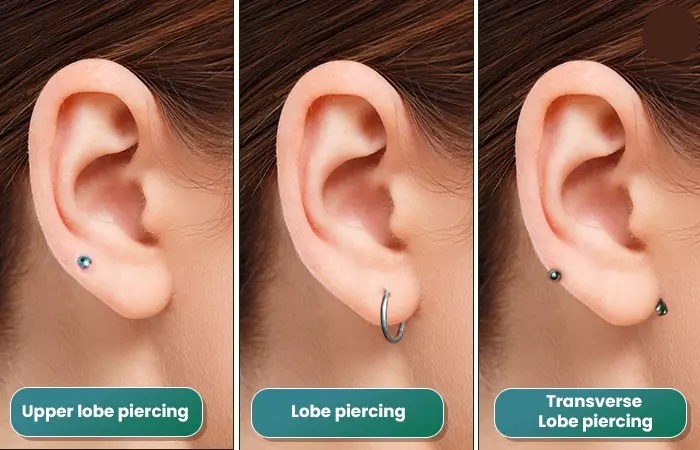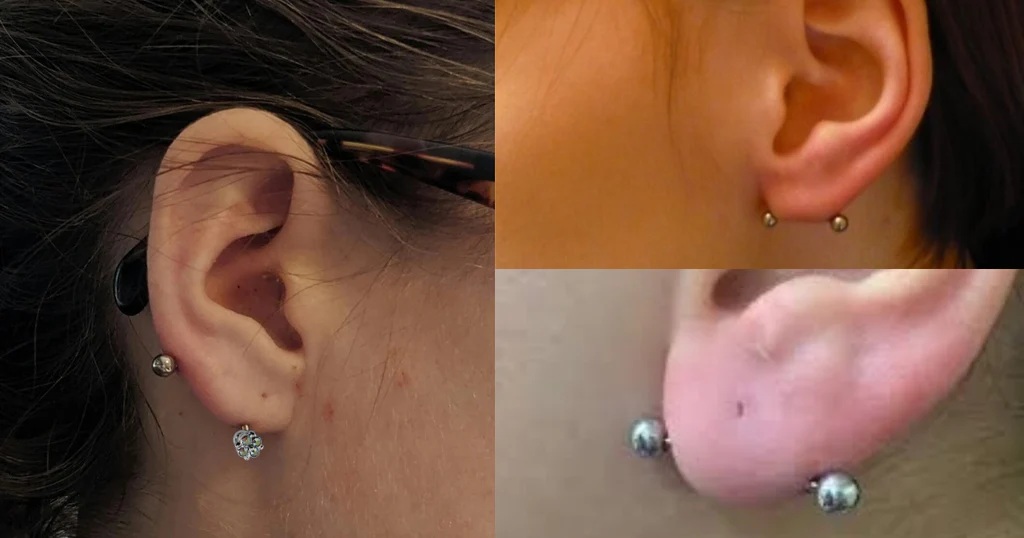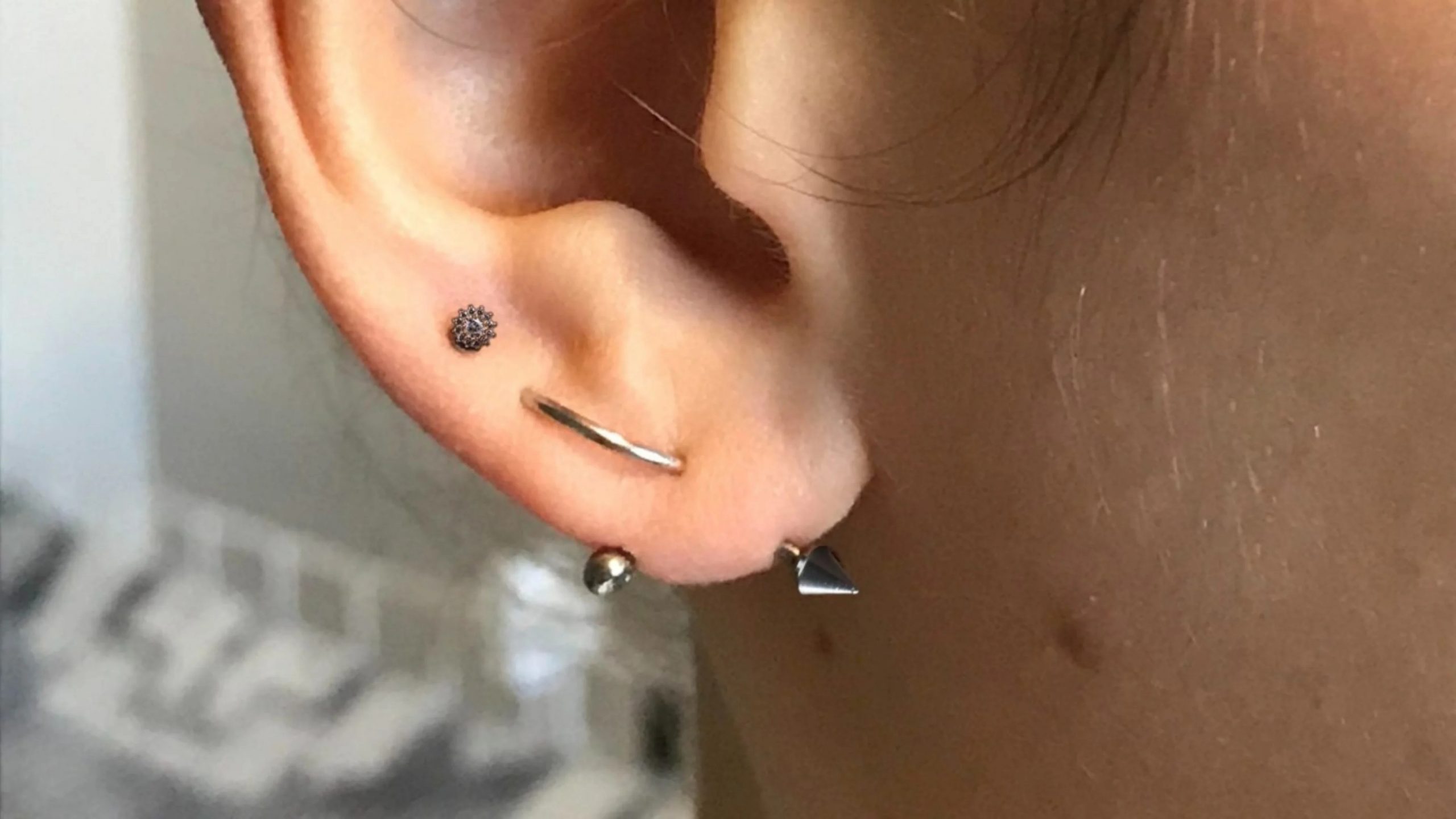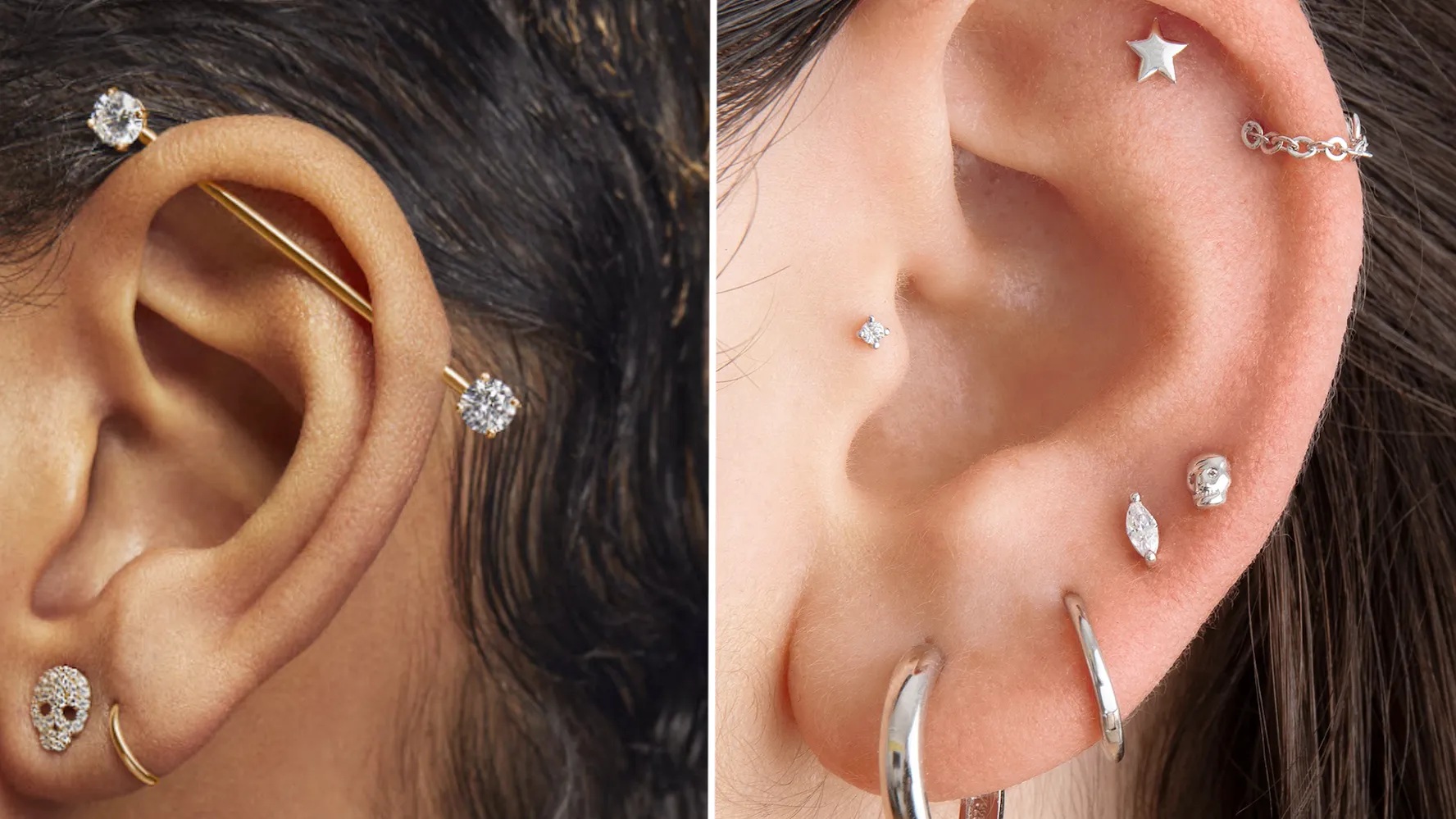When you envision an earlobe piercing, the image is almost universal: a delicate stud or a classic hoop passing directly from the front of the lobe to the back. It’s a timeless look, the very foundation of ear curation. But for the true piercing connoisseur, for the individual seeking a style that challenges convention and plays with perspective, there exists a striking and elegant alternative: the transverse lobe piercing.
Imagine a piercing that travels not front-to-back, but sideways through the very flesh of the earlobe. It creates a subtle yet captivating “peekaboo” effect, with two glittering beads visible on either side of the lobe’s curve, connected by a bar hidden within. It’s a modern, minimalist, and architectural statement that redefines what a lobe piercing can be.
However, the visual simplicity of the transverse lobe is profoundly deceptive. This is a technically demanding piercing, one whose success is almost entirely dependent on two critical factors: your unique anatomy and the profound skill of your piercer. We recently had a consultation with a client, Isabelle, a long-time piercing enthusiast with a beautifully curated collection of cartilage piercings. She came to us feeling her lobes were “empty canvases” but was uninspired by the standard placements. Our lead specialist introduced her to the concept of the transverse lobe. The consultation was not a quick one. We spent time assessing the specific shape and fullness of her earlobes, explaining that fleshier, more detached lobes are the ideal candidates. We used a gentle light to check for the placement of capillaries to ensure a safe channel could be created. After confirming she was a perfect candidate, we discussed the procedure and healing in detail. Isabelle was thrilled, not just with the unique style, but with the depth of the consultation. “I knew this was a piercing that needed an expert,” she told us, “and your process proves you are exactly that.”
Isabelle’s story is at the heart of our philosophy at PinkTatPier. This guide is an extension of that in-depth, honest consultation. It is the most comprehensive resource for anyone considering a transverse lobe London, designed to give you the knowledge to make an informed, confident decision.

transverse lobe
Deconstructing the Transverse Lobe: A Horizontal Perspective
To truly appreciate this piercing, it’s essential to understand its unique mechanics and how it differs from the piercings you’re used to seeing.
How It Works: The Sideways Channel
A transverse lobe piercing is, in essence, a surface piercing that passes through the mass of the earlobe tissue. The entry and exit holes are located on the sides of the lobe, along the bottom curve, rather than on the front and back surfaces.1 A single, long barbell is passed through this channel, making only its two decorative ends visible. This creates a clean, modern aesthetic that is unlike any other ear piercing.
Standard Lobe vs. Transverse Lobe: Key Differences
While both piercings are located on the lobe, they are worlds apart in technique, healing, and jewellery.
- Piercing Channel: A standard lobe has a very short, straight channel (front-to-back). A transverse lobe has a much longer channel (side-to-side) that must be perfectly straight to avoid pressure and rejection.
- Healing Time: A standard lobe is the fastest healing piercing, often taking only 6-8 weeks. A transverse lobe has a significantly longer and more complex healing journey, typically 8-12 months or more, due to the length of the channel through soft, vascular tissue.
- Jewellery Style: A standard lobe can wear studs, hoops, and a vast array of other styles.2 A transverse lobe is exclusively worn with a long barbell.
- Risk Profile: A standard lobe is very low-risk. A transverse lobe carries higher risks of swelling, migration, and rejection if not performed perfectly on suitable anatomy.

transverse lobe
Straight vs. Curved Barbell: A Critical Decision Made by Your Specialist
A key detail that demonstrates a piercer’s expertise is their choice of barbell.
- Straight Barbell: This is used for lobes that are full, round, and detached, allowing for a perfectly straight channel with no undue pressure.
- Curved Barbell: For lobes that are slightly flatter or have a more unique shape, a gently curved barbell may be used. A specialist will choose this to better match the natural contour of the lobe, preventing the ends of the bar from putting pressure on the tissue, which could lead to migration.
This is not a choice for the client to make; it is a technical decision your expert piercer will make during your anatomical assessment to ensure the best possible outcome for your transverse lobe London.
The Most Crucial Factor: Your Lobe Anatomy
We cannot state this strongly enough: your personal anatomy is the single most important factor in the success of a transverse lobe piercing. Not everyone is a suitable candidate, and at PinkTatPier, our commitment is to your long-term health, not just a short-term procedure.
Attached vs. Detached Lobes: Why It Matters
Generally, the ideal candidates for a transverse lobe piercing are individuals with fleshier, more pendulous, detached earlobes. This means the bottom of your earlobe hangs free from the side of your head. This type of lobe typically provides enough soft, pliable tissue to create a deep, stable channel for the barbell to sit in comfortably, far from major capillaries and with minimal tension.
Individuals with very small, thin, or attached earlobes (where the lobe connects directly to the side of the head) are often not suitable candidates. There simply isn’t enough tissue to safely accommodate the long piercing channel, and the risk of rejection is extremely high.
The PinkTatPier Anatomical Assessment: Beyond a Simple Glance
Our consultation process for a transverse lobe London is incredibly thorough, because it has to be.
- Visual Assessment: We first look at the overall size and shape of your lobe and how it hangs.
- Manual Palpation: We will gently feel the lobe tissue. We are assessing its thickness, pliability, and checking for any existing scar tissue from previous piercings that might interfere with the new channel.
- Vascular Check: We use a strong, focused light (a technique called transillumination) to look through the lobe. This allows us to get a better view of the capillary structures within the tissue. While it’s impossible to miss every tiny vessel, this step helps us choose the safest possible path for the piercing to minimise bleeding, bruising, and impact on circulation.
Our Studio’s Philosophy on Advanced Piercings:
“Our first job as professional piercers is to be honest advocates for our clients’ long-term health. With a piercing like the transverse lobe, that means meticulously assessing the tissue in three dimensions. If the lobe is too thin, has significant scar tissue, or is filled with a dense network of capillaries, we have to be the ones to say ‘no, this is not a safe choice for you.’ Our reputation is built on the piercings we don’t do just as much as the beautiful ones we perform. Safety and longevity will always come before a single procedure.” – The Lead Specialist at PinkTatPier
The Piercing Process and Healing Journey
If you are a suitable candidate, the procedure will be performed with the utmost precision, leading into a healing journey that requires patience and care.

transverse lobe
The Specialist Technique: A Precise and Gentle Approach
The piercing itself is a highly skilled procedure. After meticulously marking the entry and exit points, your specialist will use a single-use, hollow needle to create the channel in one smooth, swift motion. The goal is a perfectly straight and level channel. The long barbell is then carefully inserted and secured.
The Healing Timeline
Healing a transverse lobe is a marathon, not a sprint. The length of the channel through this soft, mobile tissue means it can be prone to swelling and irritation. The table below outlines a realistic timeline.
Table: The Transverse Lobe Healing Timeline & Milestones
| Timescale | What to Expect | Key Aftercare Actions |
| Week 1-4 | Significant swelling, tenderness, and potential bruising are very common. The earlobe may feel heavy or throb slightly. | Clean twice daily with sterile saline; avoid headphones or anything that puts pressure on the lobe; be extremely gentle when washing your hair or face. |
| Month 2-4 | Swelling will gradually reduce, but the area remains very tender to the touch. The long healing channel is extremely fragile. | Continue cleaning as needed; be hyper-aware of snagging on hair, clothing, scarves, or facemasks. DO NOT sleep on the piercing. |
| Month 4-8 | The piercing will start to feel much more stable and less prone to irritation, but it is still actively maturing internally. | Book a check-up with your piercer. Depending on your healing, downsizing the barbell to a shorter post may be possible now. |
| Month 8-12+ | The piercing is potentially fully healed. The internal fistula should be strong and robust. | Do not attempt to change the jewellery yourself or explore different decorative ends until your PinkTatPier specialist has professionally confirmed that it is fully healed. |
Consultation, Pricing & Booking Your Appointment
Due to the highly anatomical nature of this piercing, our booking process is designed to ensure your safety and success.
Why a Consultation is Mandatory
For a transverse lobe London, we require an in-person consultation before we will book the piercing procedure itself. This is a complimentary service that allows our specialists to perform the essential anatomical assessment and confirm that you are a suitable candidate. This protects you and upholds our professional standards.
How to Contact Us for a Price Quote
The final price of a transverse lobe piercing can vary depending on the length and style of the initial barbell required for your specific anatomy. We can provide a precise, no-obligation quote during your free consultation.
Your journey to this unique piercing begins when you Contact Us for your expert assessment.

transverse lobe
Frequently Asked Questions (FAQ)
1. Does a transverse lobe piercing hurt more than a standard lobe?
Yes, generally it is considered more painful than a standard lobe piercing. The needle is passing through a much greater amount of tissue, so the initial sensation is more intense and the subsequent swelling and tenderness can be more significant. However, the procedure is still very quick.
2. What are the main risks associated with a transverse lobe piercing?
The primary risks are migration and rejection, which are significantly increased if the piercing is performed on unsuitable anatomy or with the incorrect technique or jewellery. There is also a higher potential for prolonged swelling and bruising compared to other lobe piercings.
3. Can I ever stretch my transverse lobe piercing?
Absolutely not. A transverse lobe piercing cannot be stretched. Attempting to do so would put immense and uneven pressure on the tissue, leading to certain rejection and significant scarring.
Conclusion: A Unique Statement Forged by Expertise
The transverse lobe piercing is a high-impact, uniquely modern statement for those who dare to be different. It’s a testament to the fact that even the most familiar canvas can be reimagined in a bold new way. However, its success is entirely dependent on the marriage of two crucial factors: your unique anatomy and the profound skill of your piercer. It is the definition of an advanced piercing where choosing a true specialist is not just a preference—it is the only path to a safe, beautiful, and lasting result.
Your Next Step: Book Your Expert Consultation
Are you ready to explore if this unique and architectural piercing is the right choice for you?
Contact Us at our London studio to book your mandatory, complimentary consultation with one of our piercing specialists. We will provide an honest, in-depth anatomical assessment and, if you are a suitable candidate, a personalised price quote for your procedure. Let’s begin the conversation.

